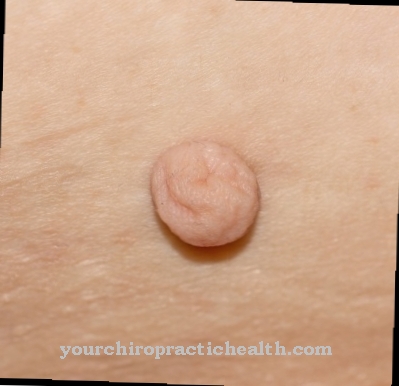blood in the eye is caused by damage to the blood vessels in the eye. It usually occurs without any further symptoms and is broken down by the body on its own after a few weeks. If blood in the eye is accompanied by other symptoms, the person affected should consult a doctor who can rule out possible diseases.
What is blood in the eye?

Blood in the eye is a build-up of blood between the leather and conjunctiva of the eye. It manifests itself in bright red spots on the eyeball. A build-up of blood can occur in the vitreous humor of the eye, causing the iris to turn red.
If the entire conjunctiva is under-blooded, it is called a hyposphagma. Blood in the eye is usually unilateral and painless. The bleeding is usually not associated with inflammation or blurred vision, but it can be accompanied by irritation to the eye. Blood in the eye is common.
causes
Various causes can cause blood vessels in the conjunctiva to tear. The result is blood in the eye.
Increased pressure on the eye, such as that experienced during physical exertion, can cause bleeding in the eye. Causes include vomiting, sneezing, coughing, straining (during defecation or childbirth), exercising, lifting heavy weights, or performing pressure equalization in the middle ear. High blood pressure can also damage blood vessels in the eye.
Injuries to the eye and eye surgery can result in bleeding in the eye, as can mechanical stimuli such as intense eye rubbing. Blood in the eye can be caused by conjunctivitis, dry eyes, or other eye diseases. Other physical illnesses, such as diabetes or blood clotting disorders, are possible causes of blood in the eye. Anticoagulant drugs can cause blood clotting disorders.
In some cases, wearing contact lenses causes bleeding in the eye, or foreign objects that have got into the eye. Blood in the eye is also more common in older people.
Diseases with this symptom
- Lassa fever
- arteriosclerosis
- thrombosis
- Chlamydia
- Inflammation of the eyes
- Dengue fever
- Leptospirosis
- Eye injuries
- Corneal inflammation
- Conjunctivitis
- Hemorrhagic fever
- Ebola
- high blood pressure
- Bleeding disorder
- blindness
Diagnosis & course
Pressure on the eye from physical exertion usually causes blood in the eye without further symptoms. The body breaks down the blood within a few weeks.
If there are underlying eye diseases, further symptoms such as burning, itching or purulent discharge can usually be expected. If vision is impaired, consider bleeding in the vitreous humor. Since blood has got behind the lens here, visual disturbances can sometimes be considerable.
A doctor will make the diagnosis and make sure there are no other diseases. The ophthalmologist uses a slit lamp for diagnosis, which allows him to see inside the eye. He rules out that a foreign body has entered the eye. If there is any suspicion of other physical illnesses, he will refer the person concerned to the respective specialist.
Complications
Blood in the eye probably “only” indicates a broken vein. Usually there are no further symptoms and after a certain time it will go away on its own. However, it could also be due to an eye disease; a visit to an ophthalmologist will provide information. Blood in the eye is relatively common, it is a collection of blood between the leather and conjunctiva. If too much blood collects in the vitreous humor, the entire iris can turn red. Usually it can only be seen in one eye and is absolutely painless. As a rule, bleeding in the eye is not accompanied by inflammation or visual disturbances.
There are many causes of blood in the eye; Sneezing, coughing, or physical exertion can cause a vessel in the eye to tear. This phenomenon is also common in sports, for example when lifting heavy weights. Pressure equalization in the middle ear or high blood pressure can also be responsible for this. Blood in the eye can occur very often after an eye operation, it is a normal reaction to the operation. Of course, eye diseases can be to blame, diabetes or bleeding disorders can also trigger blood in the eye. Sometimes the bleeding is triggered by contact lenses, but this is rarely the case. There is more blood in the eye in older people, but this is normal.
When should you go to the doctor?
Bleeding in the eye can have many causes. Since therapy may have to be started immediately or other steps taken immediately, there is no need to wait to see a doctor. In order not to provoke loss of vision, it is important to proceed quickly. If there is blood in the eye, it can even make sense to go to the eye doctor (ophthalmologist) immediately.
If an appointment cannot be made quickly enough, a visit to the family doctor is also useful. This is especially true if the bleeding is almost certainly due to traumatic external causes such as a fall or a blow. Often the blood in the eye is a bruise.
Children should never wait to see a doctor because their bodies are not yet fully developed. Obtaining medical advice is therefore always imperative.
But even with adults, waiting can be irresponsible. This is especially true if there is a reduction or loss of vision in the affected eye. In these cases, medical measures to avert danger must be initiated immediately. Otherwise there may be irreversible long-term consequences that lead to a considerable reduction in quality of life.
Doctors & therapists in your area
Treatment & Therapy
Ruptured blood vessels usually do not require treatment. However, a number of measures can make the healing process easier. This includes the application of cooling compresses. Artificial tears relieve irritation to the eye. If there are other diseases, the therapy depends on the type of disease.
For conjunctivitis, a doctor will prescribe eye drops or ointments. These are antibiotic when a bacterial infection causes conjunctivitis. After the therapy has started, the symptoms subside within one to two weeks. During this time, good hygiene must be ensured, as conjunctivitis caused by bacteria is extremely contagious.
If the person concerned suffers from diabetes or blood clotting disorders, the respective specialist initiates appropriate treatment. In the case of diabetes, the doctor recommends a low-sugar diet in addition to the administration of insulin, as an increased blood sugar level damages the blood vessels. The damage can be seen in the eyes, among other things. Large amounts of blood in the eye can damage the retina, which can lead to blindness. Treating bleeding disorders will prevent further bleeding in the eye.
If contact lenses are the cause of blood in the eye, the person concerned does not use contact lenses for a while. In cooperation with an ophthalmologist or optician, he clarifies which contact lenses he can wear in the future or whether he should do without them.
If blood occurs in the eyes of older people, a doctor will examine the eye pressure as a precaution. Permanently increased pressure in the eye can damage the optic nerve and requires immediate treatment. An ophthalmologist usually prescribes eye drops that lower eye pressure.
Outlook & forecast
If you notice blood in your own eye, you don't necessarily have to consult a doctor immediately. As a rule, these are simply broken veins, which are particularly evident on the white eyeball. The bleeding heals after just two to four days without taking medication or the like.
If this is not the case, however, one should consult a doctor. First, the cause must be clarified, why the said bleeding occurs in the eye. These causes can be varied, such as physical exertion or chronic high blood pressure.
If there is repeated bleeding in the eye, the advice of a doctor should also be sought. In rare cases, bleeding in the eye can be a symptom of an impending heart attack or stroke. Only those who consult a doctor early on can identify serious illnesses early on and have them treated accordingly.
However, if bleeding occurs once in the eye, it is not necessary to consult a doctor directly. Even without explicit treatment, the bleeding will go away within two days. Of course, anti-inflammatory drops or ointments can also be used if a slight stinging of the eyes should occur.
You can find your medication here
➔ Medicines for eye infectionsprevention
If there are underlying diseases, blood in the eye can be prevented to a limited extent. The most important preventive measure for conjunctivitis is good hygiene to avoid infection. Diabetics are encouraged to follow a healthy, low-sugar diet to keep blood sugar levels low.
Since blood in the eye caused by damaged blood vessels is usually harmless, prevention is not necessary. Frequently affected people should however seek the advice of an ophthalmologist.
You can do that yourself
If you notice blood in your own eye, you shouldn't panic. In most cases it is simply a matter of broken veins that appear painlessly on the white eyeball. Those affected can use anti-inflammatory agents to help the tissues heal more quickly. Cooling compressions, which can be held briefly on the eye, promote the healing process and lead to the regression of the red veins. Moisturizing eye ointments can also help heal faster.
In order not to strain or strain the eyes, heavy activities or exertion should be avoided entirely. Strong winds and dry heating air strain the eyes and connective tissue unnecessarily. It is therefore important to ensure constant humidity in your own four walls. Otherwise the connective tissue can continue to inflame and not regenerate as desired.
The cause of the broken veins is an overload of the body, for example lifting heavy objects. Small veins in particular are particularly sensitive to pressure, so that they burst even with low loads. As a rule, there is no need to see an ophthalmologist if the veins in the eye have burst. The conjunctiva regenerates itself after two to four days.
























.jpg)


